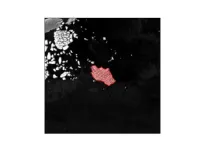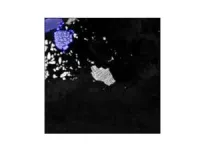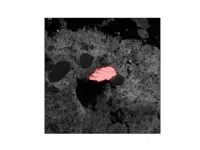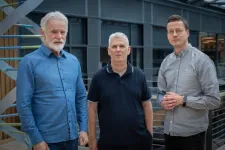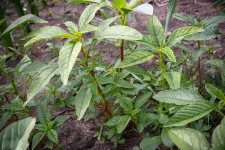(Press-News.org) AI can map giant icebergs from satellite images 10,000 times faster than humans
Scientists have trained an artificial intelligence (AI) system to accurately map - in one-hundredth of a second - the surface area and outline of giant icebergs captured on satellite images.
It is a major advance on existing automated systems which struggle to distinguish icebergs from other features in the image. Manual - or human - interpretation of the image is more accurate but it can take several minutes to delineate the outline of a single iceberg. If that has to be repeated numerous times, the process quickly becomes time-consuming and laborious.
Icebergs have a significant impact on the polar environment and monitoring them is critical for both maritime safety and scientific study. They can be extremely large - in some cases the size of small countries - and can pose a risk to passing ships. As they melt, icebergs release nutrients and freshwater into the seas, and this can have an impact on marine ecosystems.
Dr Anne Braakmann-Folgmann, who led the study while undertaking doctoral research at the Centre for Polar Observation and Monitoring at the University of Leeds, said: “Icebergs exist in hard-to-reach parts of the world and satellites are not only a fantastic tool to observe where they are, they can help scientists understand the process of how they melt and eventually begin to break apart.
“Using the new AI system overcomes some of the problems with existing automated approaches, which can struggle to distinguish between icebergs and other ice floating on the sea or even a nearby coastline which are present in the same image.”
Neural network
Dr Braakmann-Folgmann and her colleagues used an algorithm called U-net - a type of neural network - to “train” a computer to accurately map the outline of icebergs from images taken by Sentinel-1 satellites operated by the European Space Agency.
As part of the study, the effectiveness of the U-net algorithm was compared to two other state-of-the-art algorithms used to map icebergs. They are known as k-means and Otsu. The algorithms were programmed to identify the biggest iceberg in a series of satellite images.
Image 1 shows the U-net algorithm correctly identifying the iceberg, which is highlighted in red. In comparison, the k-means algorithm has incorrectly identified a cluster of smaller icebergs and ice fragments, shown in blue, as one large iceberg. That is revealed in image 2.
Image 3 shows the U-net correctly identifying the iceberg, this time surrounded by sea ice. The iceberg is highlighted in red, and the sea ice is seen as a grey structure. However, the k-means algorithm has identified the iceberg and the sea ice as a single iceberg. The algorithm is unable to differentiate between the two, despite them being distinct objects, where sea ice is rather flat ice on the sea and an iceberg stands metres above it. (Shown in image 4)
If the images are used, they must be credited: Images must be credited: Dr Anne Braakmann-Folgmann and the European Space Agency.
How the algorithm works
Animation 1 in the press pack reveals how the algorithm works. It uses an approach designed for manipulating images. By analysing the pixels in the image, it can determine the boundary or outline of objects, in this case it is identifying the outline of the iceberg.
Animation 2 compares the U-net algorithm with the much slower manual approach.
Dr Braakmann-Folgmann, now based at the Arctic University of Norway in Tromsø, said the technology could result in new services which provide information about the shape and size of giant icebergs. Current mapping services show only the midpoint or central location and length of icebergs. Interpretation by this new approach means their outline and area can be calculated.
She added: “Being able to automatically map iceberg extent with enhanced speed and accuracy paves the way for an operational service providing iceberg outlines on a regular, automated basis.
“Combining them with measurements of iceberg thickness, also enables scientists to monitor where giant icebergs are releasing vast quantities of freshwater into the oceans. There are services that give data on the location of icebergs – but not their outline or area.
Accuracy of the mapping system
The system has been tested on satellite images of seven icebergs, which were all between the size of the city of Bern - 54 km2; and Hong Kong - 1052 km2. For each of these icebergs, up to 46 images were used that covered all seasons from 2014-2020.
Over a series of tests, U-net outperformed the other two algorithms and was more effective in delineating the outline of an iceberg in images taken when environmental conditions were challenging, such as the image capturing a lot of ice structures.
On average, the U-net algorithm showed only a 5% lower estimate of the area of an iceberg. In contrast, the k-means and Otsu algorithms returned, on average - figures for iceberg area that were 150% to 170% too large, probably because the algorithms were including sea ice and even nearby coastline in the calculations.
In machine learning, the F1 score is an evaluation of how well an algorithm performs and ranges from 0 to 1, with values closer to one displaying more precision. U-net achieved an F1 score of 0.84. The two other algorithms both scored 0.62.
Andrew Shepherd, Professor at the University of Northumbria and one of the co-authors of the study, said: "This study shows that machine learning will enable scientists to monitor remote and inaccessible parts of the world in almost real-time. And with machine learning, the algorithm will become more accurate as it learns from errors in the way it interprets a satellite image.”
The paper - “Mapping the extent of giant Antarctic icebergs with Deep Learning” - will be published on 9th November 00:01 am Central European Time in the journal The Cryosphere. When the embargo lifts, the paper will be available on the journal website: https://tc.copernicus.org/articles/17/4675/2023/
END
AI can map giant icebergs from satellite images 10,000 times faster than humans
2023-11-09
ELSE PRESS RELEASES FROM THIS DATE:
People who contribute least in crowdsourcing can do the most to improve a public good
2023-11-08
Whether talking about the office kitchen, hiking trails or ratings on Yelp, there are always people who put in effort to leave those spaces better. There are also those who contribute nothing to that public good.
New research using large-scale online experiments suggests that rewarding people to contribute to a virtual public good, such as a simulated online rating for a ferry system, increased the accuracy of the ratings and improved the overall quality of that resource.
The multidisciplinary team, including researchers from the University of California, Davis; Hunter College, College of New York; the Max Planck Institute for ...
1 in 25 carries a genotype that is associated with a shortened lifespan
2023-11-08
1 in 25 carries a genotype that is associated with a shortened lifespan
Scientists at deCODE genetics, a subsidiary of Amgen, have published a study on actionable genotypes detected in the Icelandic population and their association with lifespan. The results of this study are among the things that have motivated the government of Iceland to announce a nationwide effort in precision medicine. As the delivery of precision medicine to a population requires considerable amount of data on genomics, transcriptomics and proteomics of the population, Icelanders are currently exceptionally well suited for ...
Zen and the art of mitochondrial maintenance: The machinery of death makes a healthier life
2023-11-08
While we all aspire for a long lifespan, what is most coveted is a long period of vigor and health, or “healthspan,” that precedes the inevitable decline of advancing age. Researchers at UC Santa Barbara have discovered that instruments of death that cells use to commit suicide when things go wrong contribute to making a longer and healthier life by revitalizing the specialized cellular compartments called mitochondria.
Mitochondria generate the energy for all of our activities, from movement to thought. These power plants inside our cells descended ...
MPFI researcher awarded $1.2 Million from Chan Zuckerberg Initiative
2023-11-08
Dr. Vidhya Rangaraju has been named a recipient of the Chan Zuckerberg Initiative’s “Ben Barres Early Career Acceleration Award,” which will provide her lab with $1.2 million over four years to study dysfunctions of brain energy supply.
Dr. Rangaraju is a Research Group Leader at the Max Planck Florida Institute for Neuroscience (MPFI). With this award, her lab will investigate the causes of disrupted energy supply in neurons that lead to cognitive decline in amyotrophic lateral sclerosis (ALS). ...
With new grant, RPI works to shrink microchips, expand semiconductor workforce
2023-11-08
Transistors — the tiny on-off switches inside microchips — have gotten smaller and smaller over the years, increasing computing power and enabling smaller devices. During that time, the copper wires that connect these switches have likewise shrunk.
However, smaller, thinner wires create a big problem, said Daniel Gall, professor of materials science and engineering at Rensselaer Polytechnic Institute.
“The job of the wire is to conduct electrons — electricity. Imagine a wire as a crowded hallway that the electrons have to get through. The narrower the hallway, the more the electrons bump into things and scatter. We call that resistance,” Gall ...
Single gene controls Corn Belt weed's resistance to soil-applied herbicide
2023-11-08
URBANA, Ill. — Waterhemp, the aggressive weed threatening Corn Belt crop production, is throwing curveballs once again, according to researchers at the University of Illinois Urbana-Champaign. The weed has famously developed resistance to not one or two, but seven herbicide sites-of-action classes, nearly exhausting the chemical tools farmers can use to defend their livelihood.
In a new Weed Science study, U. of I. researchers show that a single major gene is responsible for waterhemp’s resistance to S-metolachlor ...
Your education and income level may affect your survival, recovery from stroke
2023-11-08
EMBARGOED FOR RELEASE UNTIL 4 P.M. ET, WEDNESDAY, NOVEMBER 8, 2023
MINNEAPOLIS – People with low education and income levels may have a 10% increased risk of death or being dependent on others to complete daily tasks three months after a stroke compared to people with high education and income levels, according to new research published in the November 8, 2023, online issue of Neurology®, the medical journal of the American Academy of Neurology. The study does not prove that low education and income cause worse outcomes after stroke. It only shows an association.
“Compared ...
For epilepsy, yoga may be good for your mind
2023-11-08
EMBARGOED FOR RELEASE UNTIL 4 P.M. ET, WEDNESDAY, NOVEMBER 8, 2023
MINNEAPOLIS – For people with epilepsy, doing yoga may help reduce feelings of stigma about the disease along with reducing seizure frequency and anxiety, according to new research published in the November 8, 2023, online issue of Neurology®, the medical journal of the American Academy of Neurology.
“People with epilepsy often face stigma that can cause them to feel different than others due to their own health condition and that can have a significant impact on their quality of life,” said study author ...
Increasing workplace flexibility associated with lower risk of cardiovascular disease
2023-11-08
Embargoed for release: Wednesday, November 8, 4:00 PM ET
Key points:
In a randomized trial of the cardiometabolic impacts of workplace interventions designed to reduce work-family conflict, older employees and those at baseline higher risk for cardiometabolic disease saw their risk of developing cardiovascular disease decrease equivalent to five to 10 years of age-related cardiometabolic changes.
The study is among the first to assess whether changes to the work environment can affect cardiometabolic risk.
Boston, MA—Increasing workplace flexibility may lower employees’ risk of cardiovascular disease, according to a new ...
New interactive evidence-based mapping tool gives policymakers more insight into highly concentrated cannabis products
2023-11-08
After conducting the first scoping review of its kind, researchers at the University of Colorado Anschutz Medical Campus have developed an evidence based interactive mapping tool to assist policymakers as they consider regulating the concentration of THC in cannabis products and as more potent products move into the marketplace.
Their review, funded by the State of Colorado, was released today in the American Journal of Public Health (AJPH).
“We looked at studies that measured adverse or beneficial effects of high concentration ...
